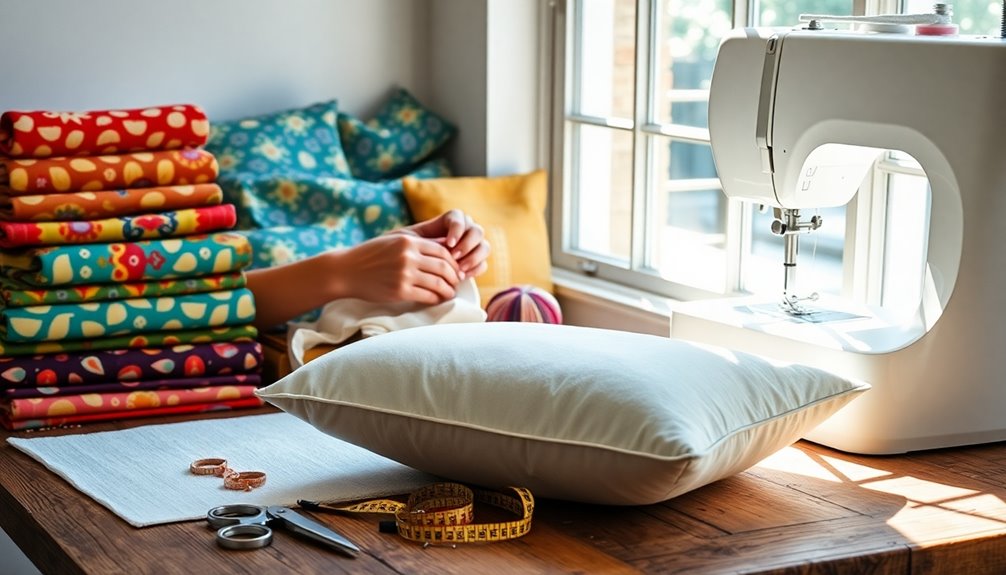To make your own sofa cushions, start by choosing durable fabric that complements your decor. Next, measure your old cushions to cut new foam to size, using high-density upholstery foam for support. If you're adding a softer touch, wrap the foam in polyester batting. Create new covers by sewing fabric pieces with a seam allowance, ensuring patterns align properly for a polished look. Also, consider adding zippers or Velcro for easy cleaning. Finally, remember to store cushions properly to prevent damage. There's plenty more to learn about maintenance and style choices that can enhance your cushion-making process.
Key Takeaways
- Measure existing cushions accurately to determine foam sizes, typically 18-24 inches in depth and 4-6 inches in thickness.
- Choose high-density upholstery foam for durability and consider adding polyester batting for added comfort and a smoother finish.
- Cut foam using an electric kitchen knife for clean edges and wrap it in durable fabric for aesthetics and ease of cleaning.
- Create new cushion covers with an extra inch for seam allowance and use Velcro closures or zippers for easy removal and washing.
- Ensure fabric pattern alignment by purchasing extra fabric and utilizing precision cutting tools like a rotary cutter for consistency.
Introduction
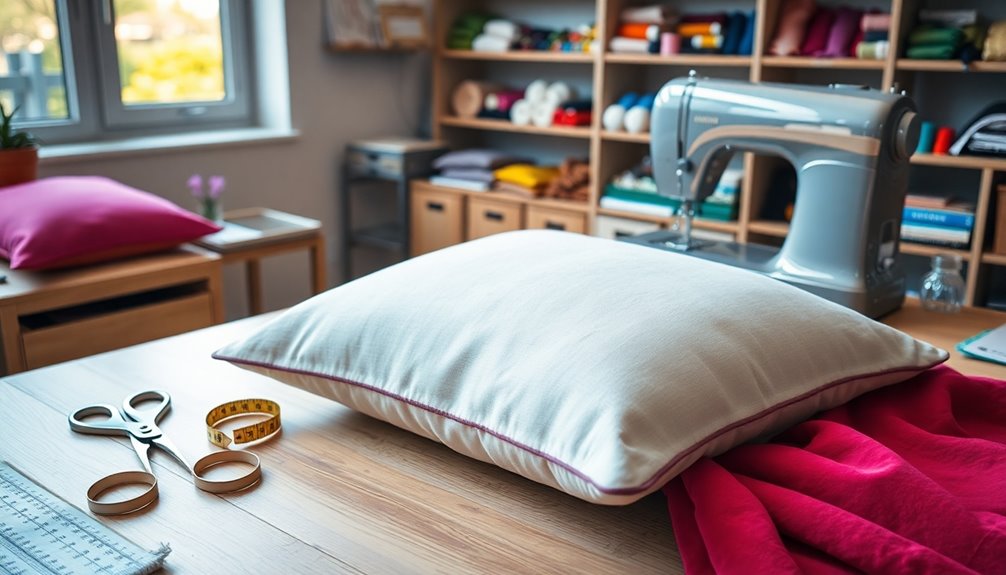
When you create your sofa cushions, it's just as important to think about how to keep them clean and fresh. Regular dusting and vacuuming will help maintain their appearance, while fabric-specific cleaning techniques ensure you don't damage the material. And if you face a wine stain, knowing how to treat it effectively can save your cushions from permanent marks.
Routine Dusting and Vacuuming
Sofa cushions can easily trap dust, allergens, and pet hair, making routine dusting and vacuuming essential for a clean and healthy living space. To maintain your couch cushions, start with regular dusting. This simple step removes surface dust and allergens, significantly improving your indoor air quality.
Vacuuming should be done at least once a week using an upholstery attachment. This method effectively captures dust, pet hair, and debris that accumulate in the fabric fibers. For the best results, vacuum your cushions both on and off the sofa. This approach ensures you reach all surfaces, including those tricky crevices and areas under the cushions.
While routine cleaning is vital, consider occasional deep cleaning sessions using a fabric-safe upholstery cleaner or a mild detergent solution to remove stains and refresh the fabric's appearance. Before you start, always check the care label on your sofa cushions for specific cleaning instructions. This way, you'll avoid damaging the fabric while keeping your cushions looking their best. By following these steps, you'll ensure your couch cushions stay clean and welcoming for you and your guests.
Fabric-Specific Cleaning Techniques
Understanding your sofa cushions' fabric is crucial for effective cleaning. Different materials require specific cleaning techniques to avoid damage. For your cotton fabric cushions, mix mild detergent with water to spot clean stains, but always test it on a hidden area first for colorfastness. If your cushions have synthetic fabrics like polyester, they may be machine washable on a gentle cycle—just check the care label to confirm.
For more delicate fabrics such as silk or velvet, it's best to use a professional upholstery cleaner or simply a soft cloth dampened with water. This minimizes the risk of harm. After cleaning, always allow your cushions to air dry completely. This step is essential to prevent mold and mildew, especially in humid conditions.
Don't forget regular maintenance! Vacuuming your cushion covers with a soft brush attachment will help maintain their appearance by removing dust and debris without causing wear. By following these fabric-specific cleaning techniques, you can ensure your sofa cushions remain fresh and inviting for years to come.
Treating Wine Stains Effectively
Even with regular maintenance, accidents can happen, and wine stains are among the most challenging to tackle. When you notice a wine stain on your cushions, act quickly. Start by blotting the area with a clean cloth or paper towel. This helps absorb as much liquid as possible without rubbing, which can spread the stain.
Next, mix a solution of two parts white wine to one part water, or opt for club soda. Gently pour it over the stain to neutralize the red wine and lift the color from the fabric. For tougher stains, apply a mixture of dish soap and hydrogen peroxide in a 1:2 ratio directly to the stain. Let it sit for about 30 minutes, then rinse with cold water.
If the stain remains stubborn, sprinkle salt on the damp area to absorb the wine and prevent it from setting. Once the salt dries, vacuum it up. Always remember to test any cleaning solution on a hidden area of the fabric first to ensure it doesn't cause discoloration or damage before applying it to the visible stain.
Avoid Direct Sunlight Exposure
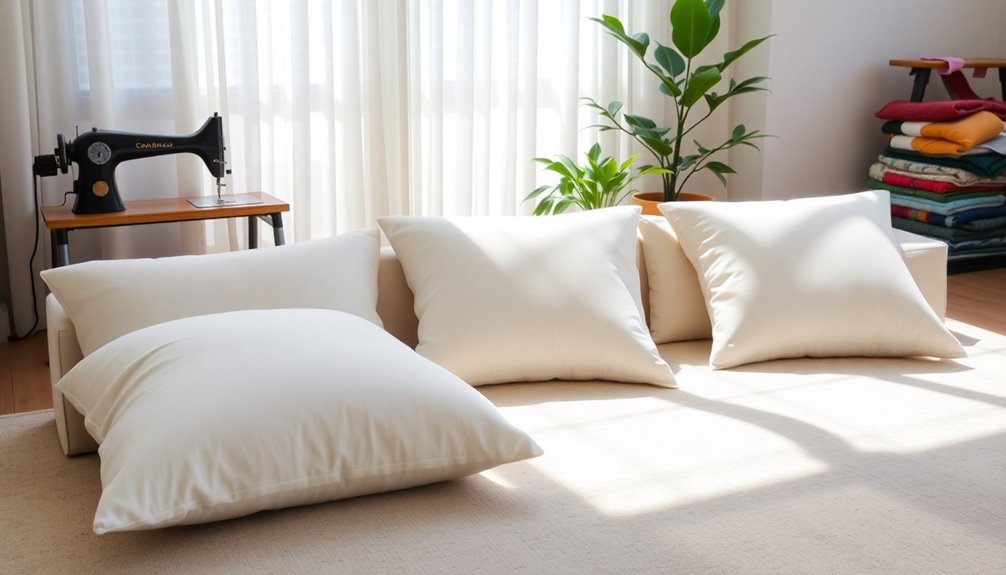
To keep your sofa cushions looking fresh, you need to protect them from direct sunlight. Choosing scratch-resistant fabrics, layering with decorative throws, and using protective fabric spray can make a big difference. These steps help maintain both the appearance and longevity of your cushions.
Scratch-Resistant Fabric Choices
When choosing scratch-resistant fabric for your sofa cushions, it's essential to prioritize materials like polyester, microfiber, or tightly woven cotton that can handle daily wear and tear. These fabrics not only resist scratches but also ensure your foam cushions stay looking fresh for longer. Look for options with a higher denier rating, ideally 600 or more, as these are generally more durable against abrasions.
Consider water-resistant or treated fabrics, which can provide extra protection against spills and stains while maintaining their scratch-resistant properties. This way, your couch remains practical and stylish, even in a busy household.
Remember to avoid placing your sofa in direct sunlight. UV exposure can degrade even the toughest fabrics, causing discoloration and reducing their lifespan. Regular maintenance is also crucial; make it a habit to vacuum your cushions and apply fabric protectors to enhance longevity.
Layer With Decorative Throws
Layering your sofa cushions with decorative throws not only boosts style but also adds comfort, especially during chilly nights. Choose throws that complement your sofa's upholstery and color scheme to create a cohesive look in your living space. This thoughtful layer enhances both the visual appeal and warmth of your seat.
When selecting your throws, opt for fabrics that are soft and inviting. To protect your cushions from fading, make sure to avoid placing them in direct sunlight. UV rays can degrade the fabric quality over time, leading to unsightly discoloration. Incorporating natural elements into your decor, such as plant-based fabrics, can further promote tranquility and enhance the overall ambiance of your space.
Regularly rotating and fluffing your decorative throws will help maintain their shape and prevent wear, keeping them looking fresh and stylish. It's also a good idea to consider removable and washable throws. This makes cleaning your sofa cushions easier and ensures they stay inviting for guests and family alike.
Use Protective Fabric Spray
Applying a protective fabric spray is a smart way to keep your sofa cushions looking fresh and clean, especially if you have kids or pets. This spray helps resist stains and spills, extending the life of your seat cushions. Make sure to choose a spray that's compatible with your specific upholstery fabric to avoid any damage.
When you apply the protective fabric spray, do it in a well-ventilated area. It's crucial to avoid direct sunlight during this process; sunlight can lead to uneven drying and discoloration. Follow the manufacturer's instructions carefully, allowing the spray to fully dry, typically taking at least 24 hours, before using the cushions again.
To maintain optimal protection against dirt and stains, plan to reapply the protective fabric spray every few months or whenever necessary. Regular maintenance is key to keeping your sofa cushions in top shape. By taking these simple steps, you can ensure your seat cushions stay vibrant and resilient, ready to handle whatever life throws at them!
Cushion Filling Replacement
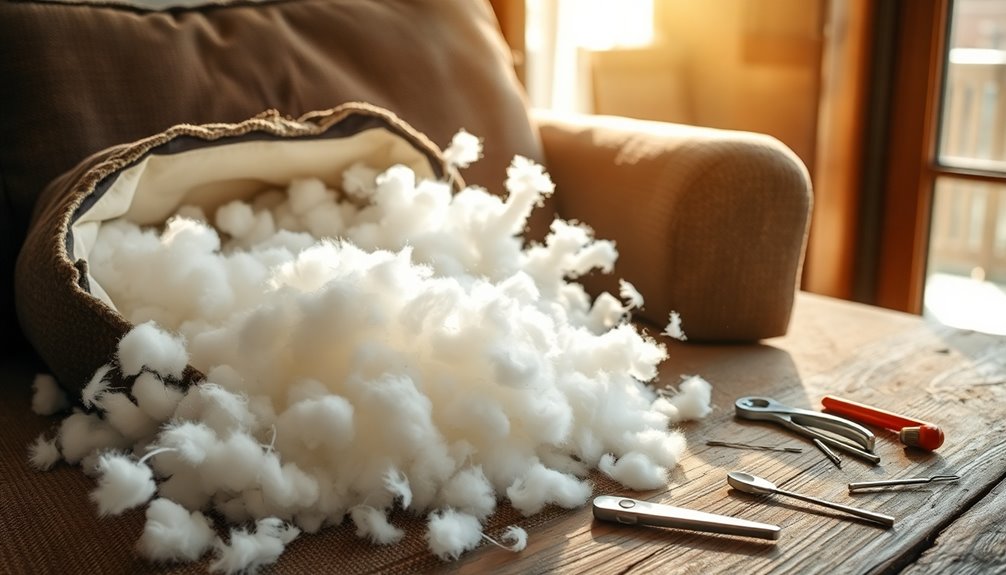
If your sofa cushions are sagging or misaligned, it might be time to replace the filling. You can revitalize your cushions with new foam while also addressing any fabric or seam repairs needed. Let's explore how to effectively refresh your sofa cushions for better support and comfort.
Cushion Sagging or Misalignment
Cushion sagging or misalignment can quickly bring down the comfort and appearance of your sofa, but you can easily tackle these issues with a few simple steps. Start by replacing old foam with high-density upholstery foam, rated between 1.8 to 2.5 pounds per cubic foot for optimal support and durability. Before purchasing, measure your existing cushions accurately, as standard couch cushions usually range from 18 to 24 inches in depth and 4 to 6 inches in thickness.
To enhance comfort further, consider adding polyester batting around the new foam. This creates a softer edge and helps achieve a smoother appearance once the cushions are covered. If your cushions are misaligned, ensure the foam is cut evenly, and that the fabric covers are sewn to the correct dimensions, allowing for about 1 inch of seam allowance.
Lastly, to maintain the shape and support of your foam cushions, regularly rotate and fluff them. This simple practice prevents uneven wear and prolongs the life of the foam, ensuring your sofa remains comfortable and visually appealing for years to come.
Fabric and Seam Repair
Once you've tackled sagging or misaligned cushions, it's time to address the fabric and seams. Begin by removing the existing fabric covering with a seam ripper, which will expose the cushion filling for assessment. Check the filling material; if it's worn out or flattened, you'll want to replace it to ensure your seat cushion remains comfortable and supportive. High-density foam or polyester batting are great choices for this.
Next, select a durable fabric for reupholstering. Materials like canvas or denim can withstand everyday wear and tear, making them perfect for your sofa. When you're ready to sew, create new cushion covers using a sewing machine. Remember to add an extra inch for seam allowances and maintain a consistent seam technique for a professional finish.
For a polished and practical look, consider using Velcro closures or zippers on the cushion covers. This way, you can easily remove and wash the fabric whenever needed, keeping your seat cushion fresh and looking great. Additionally, selecting a fabric that can resist scratching from pets will help maintain the integrity of your newly made cushions. With these steps, you'll have your cushions looking brand new in no time!
Revitalize With New Foam
Revamping your sofa's comfort starts with replacing old foam, a crucial step in enhancing support and durability. Using high-density upholstery foam, you'll improve the overall feel of your couch cushion, making it much more inviting. Aim for a thickness of 4 to 6 inches for the best seating experience.
Before you cut the new foam, accurately measure your existing cushion dimensions with a measuring tape and mark them with a pencil. For cutting, an electric kitchen knife works wonders; it slices through dense materials without tearing or damaging them, ensuring clean edges.
If you want to add an extra layer of comfort, consider wrapping the new foam in polyester batting. This will create softer edges and elevate the overall comfort of your cushions. After wrapping, encase the foam in a durable fabric cover that complements your decor. This not only looks great but also allows for easy removal and cleaning whenever necessary. Additionally, using essential oils for aromatherapy can enhance the ambiance of your living space while you enjoy your newly revitalized sofa.
Fabric Pattern Alterations
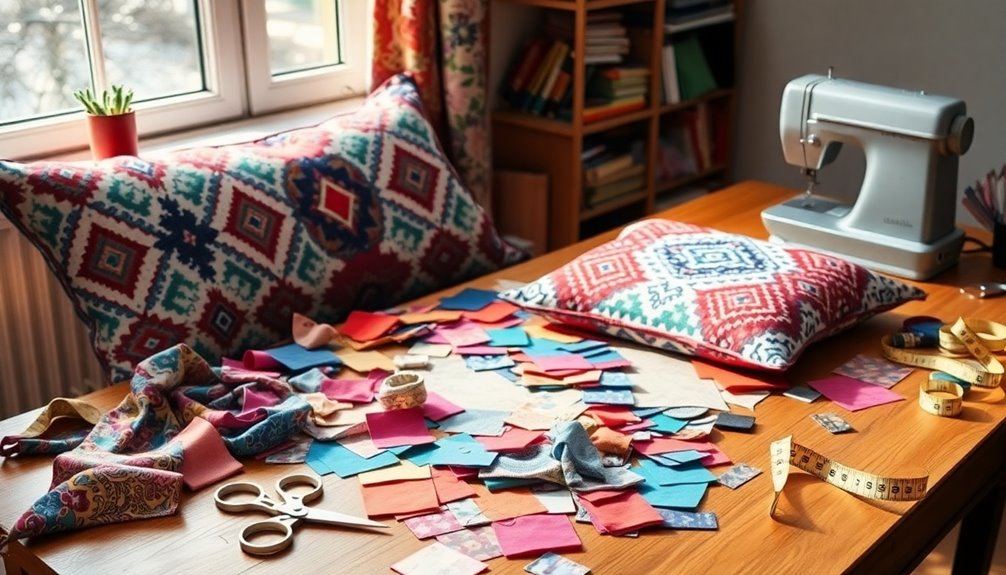
When choosing fabric for your sofa cushions, it's crucial to consider how the pattern aligns with seams and edges. To achieve a polished look, make sure to buy extra fabric to account for pattern matching. Lay the fabric out flat and adjust your cutting layout to maintain continuity across all cushion covers.
Carefully measure and mark each fabric piece, ensuring that patterns are cut in the same direction. This helps maintain visual consistency when the cushions are placed together. Using a rotary cutter and cutting mat will give you clean edges, especially with intricate patterns that require precision.
After sewing your cushion covers, inspect the pattern alignment at the seams. If you notice any misalignments, take the time to make adjustments for a seamless flow across the cushions. By focusing on these fabric pattern alterations, you'll ensure that your cushions not only fit perfectly but also enhance the overall aesthetic of your sofa. Remember, a little extra attention in this step will make a significant difference in the final product, giving your cushions the perfect size and look you desire.
Seasonal Storage Tips

After you've perfected your sofa cushion covers, it's important to think about how to store them during the off-seasons. Start by cleaning and airing out your cushions to prevent mold and mildew. Make sure they're completely dry before packing them away. Using breathable storage bags or containers is essential; these will protect your cushions from dust and moisture while allowing air circulation to avoid musty odors.
Store the cushions in a cool, dry place, away from direct sunlight to prevent fading and deterioration of both fabric and foam. If you're tight on space, consider using vacuum-sealed bags, but remember not to compress the cushions for too long. This helps maintain their shape and support.
Regularly check your stored cushions for any signs of pests or damage. If you're opting for long-term storage, rotate their position occasionally to ensure even wear. If you need extra protection, you might want to add a piece of batting between cushions. You can find this at your local fabric store, making it easy to enhance your cushions' longevity.
Conclusion
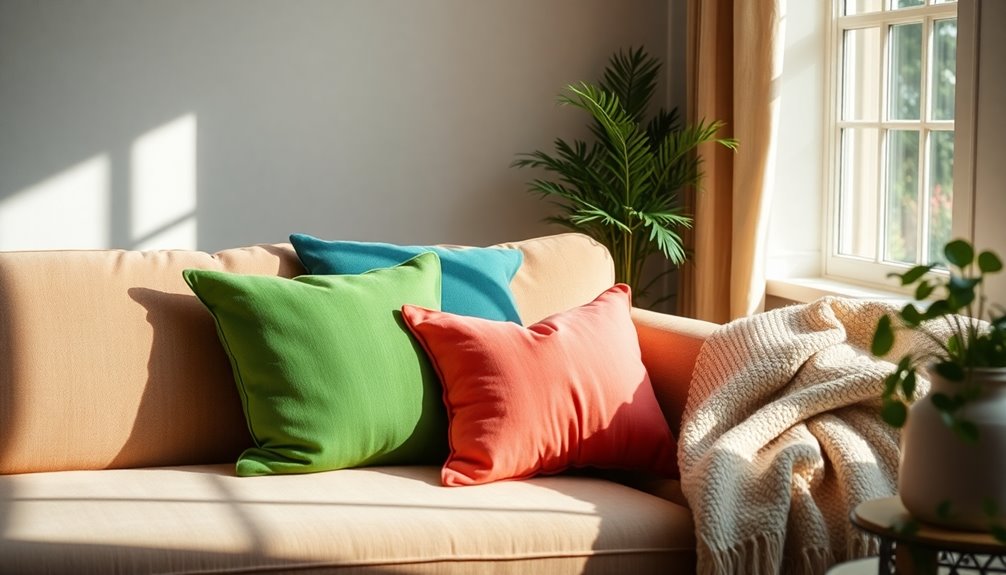
In conclusion, creating your own sofa cushions not only allows you to customize your living space but also ensures comfort and durability. By selecting high-density upholstery foam and durable fabric, you can achieve cushions that stand the test of time. Accurate measurements are key; make sure to cut your foam and fabric to the right dimensions, typically 18-24 inches deep and 4-6 inches thick, allowing for seams.
The assembly process is straightforward. After you've cut the foam and fabric, sew the fabric covers with the proper seam allowance. When you're ready, securely insert the foam into the covers, ensuring a snug fit. This attention to detail enhances both comfort and aesthetics.
Don't forget about maintenance! Regularly fluff your cushions and spot clean them to keep them looking fresh. Plus, customizing the design with different fabric patterns and colors gives you the chance to express your personal style while enhancing your sofa's overall look. By taking these steps, you'll not only create beautiful cushions but also enjoy a cozy, inviting space that reflects your taste.
Frequently Asked Questions
What Is the Best Filling for Sofa Seat Cushions?
When you're choosing the best filling for your sofa seat cushions, consider high-density polyurethane foam for firm support and durability. If you prefer a softer touch, memory foam molds to your body, offering great comfort, though it might need more upkeep. For a luxurious feel, down and feather blends are excellent, but they compress quickly. Polyester fiberfill is a budget-friendly option, while quick-dry foam is ideal for outdoor sofas, resisting water and mold.
How Many Yards of Fabric Do I Need for a Couch Cushion?
To figure out how many yards of fabric you need for a couch cushion, start by measuring your cushion size. For standard cushions, you'll generally need about 1 yard of fabric per cushion cover, factoring in seam allowances. If you're making several cushions, multiply the number of cushions by the fabric needed for one. Don't forget to consider pattern alignment and maybe grab an extra half yard for any mistakes!
How to Make a Saggy Couch More Comfortable?
To make your saggy couch more comfortable, start by replacing the cushions with high-density foam. This foam should be about 4-6 inches thick for the best support. Next, add a layer of polyester batting to soften the surface. Regularly rotate and fluff your cushions to maintain their shape, and consider placing a plywood board underneath for added stability. These steps will enhance your sitting experience and help reduce discomfort over time.
How Much Does It Cost to Make Couch Cushions?
When you're considering the cost to make couch cushions, you'll find it varies based on materials. Expect to spend around $250 for a DIY project, which includes high-density foam costing $30 to $100 per sheet and upholstery fabric ranging from $10 to $50 per yard. You'll also need extra materials like batting and thread, adding another $20 to $50. If you prefer pre-made options, prices can start at $50 and go above $200.
